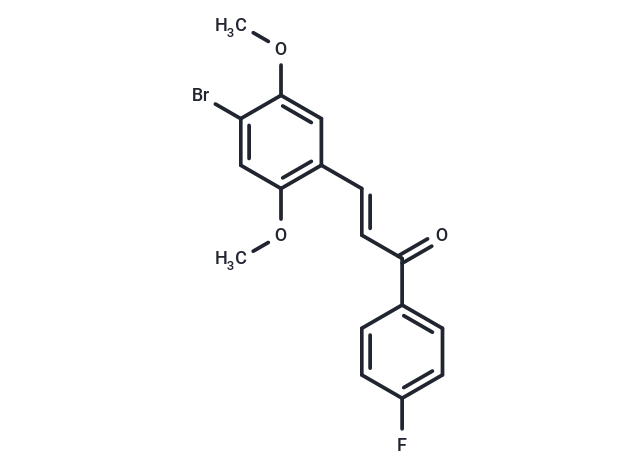Shopping Cart
Remove All Your shopping cart is currently empty
Your shopping cart is currently empty
NLRP3-IN-10 (ZVN26391) is a potent NLRP3 inhibitor. NLRP3-IN-10 inhibits IL-1β release with an IC50 value of 251.1 nM. NLRP3-IN-10 attenuates ASC speck formation, leading to suppress activation of NLRP3 inflammasome.

| Pack Size | Price | USA Warehouse | Global Warehouse | Quantity |
|---|---|---|---|---|
| 5 mg | $39 | In Stock | In Stock | |
| 10 mg | $64 | In Stock | In Stock | |
| 25 mg | $128 | In Stock | In Stock | |
| 50 mg | $197 | In Stock | In Stock | |
| 100 mg | $328 | In Stock | In Stock | |
| 200 mg | $489 | - | In Stock | |
| 1 mL x 10 mM (in DMSO) | $59 | In Stock | In Stock |
| Description | NLRP3-IN-10 (ZVN26391) is a potent NLRP3 inhibitor. NLRP3-IN-10 inhibits IL-1β release with an IC50 value of 251.1 nM. NLRP3-IN-10 attenuates ASC speck formation, leading to suppress activation of NLRP3 inflammasome. |
| In vitro | NLRP3-IN-10 (compound 14c) significantly inhibits NLRP3 inflammasome activation in THP-1 cells by LPS-MSU, demonstrating dose-dependent efficacy at 0.4-6.4 μM over 40 minutes. It is non-toxic to THP-1 cells at 0.1-6.4 μM after 1.5 hours and prevents Nigericin-induced pyroptosis at 0.1 and 0.4 μM. The compound reduces caspase-1 p20 and IL-1β production dose-dependently at 0.1, 0.2, and 0.4 μM, and decreases LPS-induced TNF-α production at 3 and 5 μM. NLRP3-IN-10 also reduces ASC specks formation at 0.2 and 0.8 μM, indicating interruption of ASC oligomerization. Furthermore, it inhibits LPS-induced NLRP3 priming by directly interacting with NLRP3 at 1, 10, and 100 μM, demonstrating potential in regulating both priming and activation steps in the NLRP3 inflammasome pathway. |
| In vivo | NLRP3-IN-10 (compound 14c), administered via a single intravenous (i.v.) dose of 10 mg/kg, effectively reduced peritoneal neutrophil influx and IL-1β levels in the spleen in a LPS-primed mouse model with MSU-induced peritonitis. Additionally, oral administration of NLRP3-IN-10 at doses of 10, 30, and 90 mg/kg demonstrated very low systemic exposure (14.6 to 23.53 μg·h/L), limited bioavailability (2.47 to 13.79%), and high plasma clearance rates (2201.58 to 5551.12 L/h/kg), indicating significant challenges in its pharmacokinetic profile when administered orally. Pharmacokinetic data revealed an area under the curve (AUC) ranging from 14.60 to 23.53 μg·h/L, clearance (CL) rates between 2201.58 and 5551.12 L/h/kg, and maximal concentration (Cmax) values from 3.35 to 81.97 μg/L across different administration routes and dosages. The study was conducted on 7-week-old male C57BL/6J mice induced with MSU-induced peritonitis and primed with LPS (1 mg/kg, i.p.), showing a notable reduction in spleen IL-1β release and peritoneal neutrophil influx following a 6-hour treatment with a 10 mg/kg intravenous dose of NLRP3-IN-10, when compared to the control group. |
| Synonyms | ZVN26391 |
| Molecular Weight | 365.19 |
| Formula | C17H14BrFO3 |
| Cas No. | 2641826-39-1 |
| Smiles | COc1cc(\C=C\C(=O)c2ccc(F)cc2)c(OC)cc1Br |
| Storage | Powder: -20°C for 3 years | In solvent: -80°C for 1 year | Shipping with blue ice/Shipping at ambient temperature. | ||||||||||||||||||||
| Solubility Information | DMSO: 4.4 mg/mL (12.05 mM), Sonication is recommended. | ||||||||||||||||||||
Solution Preparation Table | |||||||||||||||||||||
DMSO
| |||||||||||||||||||||
| Size | Quantity | Unit Price | Amount | Operation |
|---|

Copyright © 2015-2026 TargetMol Chemicals Inc. All Rights Reserved.